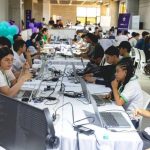Europe is at the forefront of advances in quantum cybersecurity and recently demonstrated its leadership through an outstanding live presentation. The event also showcased important contributions from Spanish experts in this field.
The Polytechnic University of Madrid (UPM) in Spain, in collaboration with leading European companies and organizations, participated in this ultra-secure videoconferencing demonstration during the “Digital Assembly” organized by the Swedish Presidency of the Council of the European Union and the European Commission.
The event took place on June 15 in Stockholm.
The demonstration consisted of a videoconference between the main stage of the event and the exhibition area. The videoconference was protected by an emerging technology that encrypts the information that is shared to make it immune to any attack.
This technology is based on quantum communication, which takes advantage of the fundamental properties of quantum mechanics to achieve unprecedented levels of security. Using what is known as “quantum key distribution”, it is possible to make data transmitted over a network invulnerable to any malicious attempt at interception or decryption, even if the attacker is a quantum computer. With the rise of sophisticated cyber threats, the development of quantum communication technologies offers a secure path for the protection of sensitive information and for enabling new, trusted communication channels.
The novelty of this live videoconference is that it is the first technical demonstration, at scale, of what will be called the European Quantum Communications Infrastructure (EuroQCI): an ambitious collaboration signed by the 27 Member States, the European Commission and the Agency European Space. Its objective? Establish an ultra-secure communications channel for public administrations, safeguard critical infrastructures and strengthen encryption systems throughout the European Union.
The recent demonstration of ultra-secure video conferencing using quantum cybersecurity is very encouraging for the future of this technology. (Image: UPM)
To carry out the connection, the information traveled securely between the laboratories and facilities of the different participating organizations, which processed it remotely from different locations in Spain, Italy, Germany and Sweden, among others, to connect, in a way securely, both ends of the video conference.
To make it possible, two pairs of quantum devices supplied by QTI, an Italian company, and LuxQuanta, from Spain, were used to make up the quantum layer of the infrastructure. These devices established secure quantum keys between two locations, guaranteeing maximum communication protection. The demonstration was supported by Ericsson, a Swedish company, the Royal Institute of Technology (KTH) in Stockholm and the European consortium PETRUS.
The Polytechnic University of Madrid played a central role in this experiment: the Quantum Information Research group of the CCS (Center for Computational Simulation) contributed, in addition to its extensive experience, the network design of the experiment itself and innovative network software based on in the disruptive software-defined network (SDN) paradigm, with which you can manage quantum keys as well as all network elements, including quantum communications devices, encryptors, applications, etc., in a fully transparent manner. The technology also uses standards developed in Europe that have also been promoted by the UPM.
This software enables the creation of complex quantum networks, and plays a fundamental role in the operation, device integration and resource management of the Madrid Quantum Network (MadQCI), the fourth generation of quantum networks in the region, the most largest in size and with the most complex operation of the European Union. The technology, based on the SDN paradigm, developed by the UPM, makes it possible for new network technologies, such as those based on quantum mechanics, to operate in cooperation with the classical networks that we usually use, facilitating the integration of the different devices from the various providers. industries participating in the network. This function is key to a technology, quantum communication, whose development is incipient and whose milestones, patents and commercial products are being developed in different parts of the world, each with its own language and specifications. (Source: UPM)










![[Img #68772]](https://thelatestnews.world/wp-content/uploads/2023/06/Quantum-cybersecurity-for-ultra-secure-video-conferencing.jpg)
